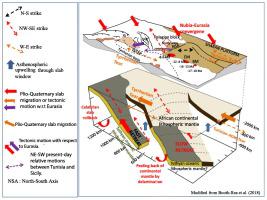当前位置:
X-MOL 学术
›
Tectonophysics
›
论文详情
Our official English website, www.x-mol.net, welcomes your
feedback! (Note: you will need to create a separate account there.)
On the origin and consequences of crustal-scale extension between Africa and Sicily since Late Miocene: insights from the Kaboudia area, western Pelagian Sea
Tectonophysics ( IF 2.7 ) Pub Date : 2020-11-01 , DOI: 10.1016/j.tecto.2020.228565 Mohamed Arab , Chokri Maherssi , Didier Granjeon , François Roure , Jacques Déverchère , Laurent Cuilhé , Mohamed Hassaim , Nicolas Mouchot , Stefan Doublet , Sami Khomsi
Tectonophysics ( IF 2.7 ) Pub Date : 2020-11-01 , DOI: 10.1016/j.tecto.2020.228565 Mohamed Arab , Chokri Maherssi , Didier Granjeon , François Roure , Jacques Déverchère , Laurent Cuilhé , Mohamed Hassaim , Nicolas Mouchot , Stefan Doublet , Sami Khomsi

|
Abstract The eastern Tunisian shelf is located between the Gulf of Hammamet and the Gulf of Gabes and belongs to the Pelagian domain which underwent a continuous NE-directed extension and crustal thinning since Late Miocene. This geodynamic process induced the formation of NW striking normal faults and associated grabens both in the Tunisian Atlas and the Pelagian domain, including the Sicily Channel rifting zone (SCRZ). In this study, we combine regional stratigraphy from seismic reflection profiles, focal mechanisms, space geodetic measurements (GNSS) and thermal indicators from well data to propose a backward tectonic reconstitution of the Pelagian domain. The thinning of the continental crust is demonstrated by gravity inversion integrating published seismic refraction profiles. By completing the interpretation of tectono-stratigraphic records, we highlight a northeastward propagation of extension prevailing within the Pelagian shelf from Messinian to Plio-Quaternary times. We suggest that extensional tectonics is explained by (1) eastward slab tearing between the African continental lithosphere and the Tethyan oceanic slab, allowing asthenospheric upwelling, and (2) forces arising from relative motions between Nubia and the Hyblean-Malta block. The decoupling of these domains since Late Miocene likely results from a combination of the NW-directed plate convergence, inherited rheological contrasts within the continental crust, and weakening arising from mantle flow induced by the Tethyan slab rollback and tearing.
中文翻译:

自晚中新世以来非洲和西西里地壳尺度伸展的起源和后果:来自西伯拉纠海卡布迪亚地区的见解
摘要 突尼斯东部陆架位于哈马马特湾和加贝斯湾之间,属于伯拉纠域,自晚中新世以来经历了连续的NE向伸展和地壳减薄。这种地球动力学过程在突尼斯阿特拉斯和伯拉纠域,包括西西里海峡裂谷带 (SCRZ) 中导致了 NW 显着正断层和相关地堑的形成。在这项研究中,我们结合了来自地震反射剖面、震源机制、空间大地测量 (GNSS) 和井数据热指标的区域地层学,提出了伯拉纠域的后向构造重建。结合已发表的地震折射剖面的重力反演证明了大陆地壳变薄。通过完成构造地层记录的解释,我们强调了从墨西拿时代到 Plio-第四纪时期在伯拉纠大陆架内盛行的向东北传播的延伸。我们认为拉伸构造可以通过以下方式解释:(1)非洲大陆岩石圈和特提斯大洋板块之间向东的板块撕裂,允许软流圈上涌,以及(2)努比亚和海布尔-马耳他地块之间的相对运动产生的力。自晚中新世以来,这些域的解耦可能是由 NW 导向的板块辐合、大陆地壳内继承的流变对比以及由特提斯板块回滚和撕裂引起的地幔流减弱的综合结果。我们认为拉伸构造可以通过以下方式解释:(1)非洲大陆岩石圈和特提斯大洋板块之间向东的板块撕裂,允许软流圈上涌,以及(2)努比亚和海布尔-马耳他地块之间的相对运动产生的力。自晚中新世以来,这些域的解耦可能是由 NW 导向的板块辐合、大陆地壳内继承的流变对比以及由特提斯板块回滚和撕裂引起的地幔流减弱的综合结果。我们认为拉伸构造可以通过以下方式解释:(1)非洲大陆岩石圈和特提斯大洋板块之间向东的板块撕裂,允许软流圈上涌,以及(2)努比亚和海布尔-马耳他地块之间的相对运动产生的力。自晚中新世以来,这些域的解耦可能是由 NW 导向的板块辐合、大陆地壳内继承的流变对比以及由特提斯板块回滚和撕裂引起的地幔流减弱的综合结果。
更新日期:2020-11-01
中文翻译:

自晚中新世以来非洲和西西里地壳尺度伸展的起源和后果:来自西伯拉纠海卡布迪亚地区的见解
摘要 突尼斯东部陆架位于哈马马特湾和加贝斯湾之间,属于伯拉纠域,自晚中新世以来经历了连续的NE向伸展和地壳减薄。这种地球动力学过程在突尼斯阿特拉斯和伯拉纠域,包括西西里海峡裂谷带 (SCRZ) 中导致了 NW 显着正断层和相关地堑的形成。在这项研究中,我们结合了来自地震反射剖面、震源机制、空间大地测量 (GNSS) 和井数据热指标的区域地层学,提出了伯拉纠域的后向构造重建。结合已发表的地震折射剖面的重力反演证明了大陆地壳变薄。通过完成构造地层记录的解释,我们强调了从墨西拿时代到 Plio-第四纪时期在伯拉纠大陆架内盛行的向东北传播的延伸。我们认为拉伸构造可以通过以下方式解释:(1)非洲大陆岩石圈和特提斯大洋板块之间向东的板块撕裂,允许软流圈上涌,以及(2)努比亚和海布尔-马耳他地块之间的相对运动产生的力。自晚中新世以来,这些域的解耦可能是由 NW 导向的板块辐合、大陆地壳内继承的流变对比以及由特提斯板块回滚和撕裂引起的地幔流减弱的综合结果。我们认为拉伸构造可以通过以下方式解释:(1)非洲大陆岩石圈和特提斯大洋板块之间向东的板块撕裂,允许软流圈上涌,以及(2)努比亚和海布尔-马耳他地块之间的相对运动产生的力。自晚中新世以来,这些域的解耦可能是由 NW 导向的板块辐合、大陆地壳内继承的流变对比以及由特提斯板块回滚和撕裂引起的地幔流减弱的综合结果。我们认为拉伸构造可以通过以下方式解释:(1)非洲大陆岩石圈和特提斯大洋板块之间向东的板块撕裂,允许软流圈上涌,以及(2)努比亚和海布尔-马耳他地块之间的相对运动产生的力。自晚中新世以来,这些域的解耦可能是由 NW 导向的板块辐合、大陆地壳内继承的流变对比以及由特提斯板块回滚和撕裂引起的地幔流减弱的综合结果。







































 京公网安备 11010802027423号
京公网安备 11010802027423号